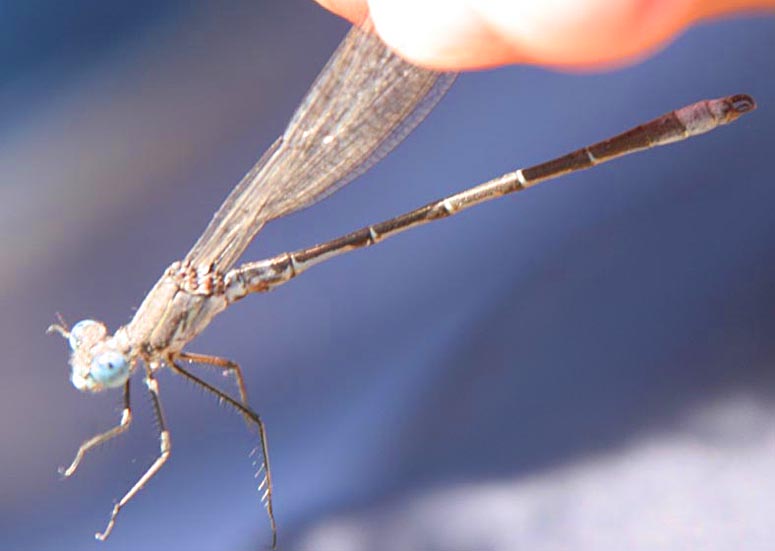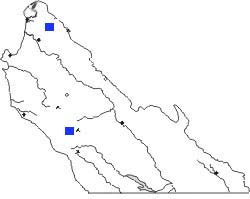| |
|
|
BLACK SPREADWING
Lestes
stultus
|

Black Spreadwing is a
black-and-white pond spreadwing that is
widespread
through the California lowlands. Its status in Monterey County is not
known
as there are currently only two specific records. Yet these are so far
apart that one suspects it is also a widespread ode of temporary ponds
and marshes throughout the MTY foothills. The photos (above &
below)
are of MTY's second record, found by Steve Rovell on 14 July 2006 at a
pond east of Salinas. It is a nice male with black-and-white abdominal
pattern and blue eyes.
photos (above
& below) 14 July 2006
at Lagunita Lake
© Steve Rovell, used with
permission
|
 I
use Rovell's full-frame shot (right) to illustrate the actual size of
this
spreadwing: about 2 inches long. Yet it is considered to be the
"largest
and
stockiest" of our local pond spreadwings (Manolis 2003). Like all the
spreadwings,
it perches with the wings spread apart. Recent genetic evidence
suggests
that spreadwings are not part of the damselfly suborder but are either
better placed within the dragonfly suborder, or, possibly, in an
intermediate
position, similar to a "living fossil" suborder in eastern Asia [see
the
discussion of "taxonomy and phylogeny" on the MTY
Checklist page]. I
use Rovell's full-frame shot (right) to illustrate the actual size of
this
spreadwing: about 2 inches long. Yet it is considered to be the
"largest
and
stockiest" of our local pond spreadwings (Manolis 2003). Like all the
spreadwings,
it perches with the wings spread apart. Recent genetic evidence
suggests
that spreadwings are not part of the damselfly suborder but are either
better placed within the dragonfly suborder, or, possibly, in an
intermediate
position, similar to a "living fossil" suborder in eastern Asia [see
the
discussion of "taxonomy and phylogeny" on the MTY
Checklist page]. |
|
|
In Steve Rovell's close-up shot of the male
appendage, we can see the
important i.d. features for Black Spreadwing. The two curved cerci are
outermost, and between them are the two paraprocts (lower appendages).
These are long and 'foot-shaped' at their tips, with the 'feet' toeing
inward. |
The first MTY record of Black Spreadwing was found by Paul Johnson on 2
July 2005 along the upper Arroyo Seco River, "5 km SW of Junipero Serra
peak, at the crossing of Arroyo Seco [=Indians?] Road, lat/long: N
36.14°
W 121.46° N" per the details on the Univ. of Texas web site. The
elevation
here was 690 m., and the habitat described as a "small, sluggish, shady
stream." It is said that the specimen "will be deposited in Essig
Museum
of Entomology, UC Berkeley." This was just north of The Indians and
just
before the road is closed by a gate.
At Lake Lagunitas, on private property in the
Diablo Range foothills
east of Salinas, Rovell found MTY's second L. stultus along the
edge of reeds growing in a farm pond that is used as a drinking spot
for
cattle. The Arroyo Seco River site, and the Lake Lagunitas site are a
long
distance apart and are in the foothills of different mountain ranges.
This
makes me suspect that Black Spreadwing is waiting to be found at many
sites
with reedy ponds or slow streams in-between.
|
 Black
Spreadwing is currently known from only two sites, but is
probably more widespread. Black
Spreadwing is currently known from only two sites, but is
probably more widespread.
Both records so far are from July. Elsewhere
in California, the flight
dates range from April through July, with very few still flying into
September
(Manolis 2003).
|
|
| On a taxonomic note, Manolis (2003) cites genetic
studies that show
a very close relationship between Black Spreadwing and Emerald
Spreadwing Lestes
dryas, a widespread montane species in California's higher
mountains.
Although the color pattern between the two is quite different, the male
appendages are also very similar. |
|
Literature cited:
- Manolis, T. 2003. Dragonflies and Damselflies of
California. Univ. of
Calif.
Press, Berkeley.
Web resources:
Major identification web sites with much information on California
odes include:
For sites with excellent photos to compare for identification or to
simply
enjoy, see:
Many of these sites have links to other useful pages. Kathy Biggs's
site
is particularly useful in her selection of links. |
|
All text © Don Roberson 2007; photos
© Steve Rovell 2006, used with permission
TOP
|
|
|
|
|
|
|
|
|

 Black
Spreadwing is currently known from only two sites, but is
probably more widespread.
Black
Spreadwing is currently known from only two sites, but is
probably more widespread.